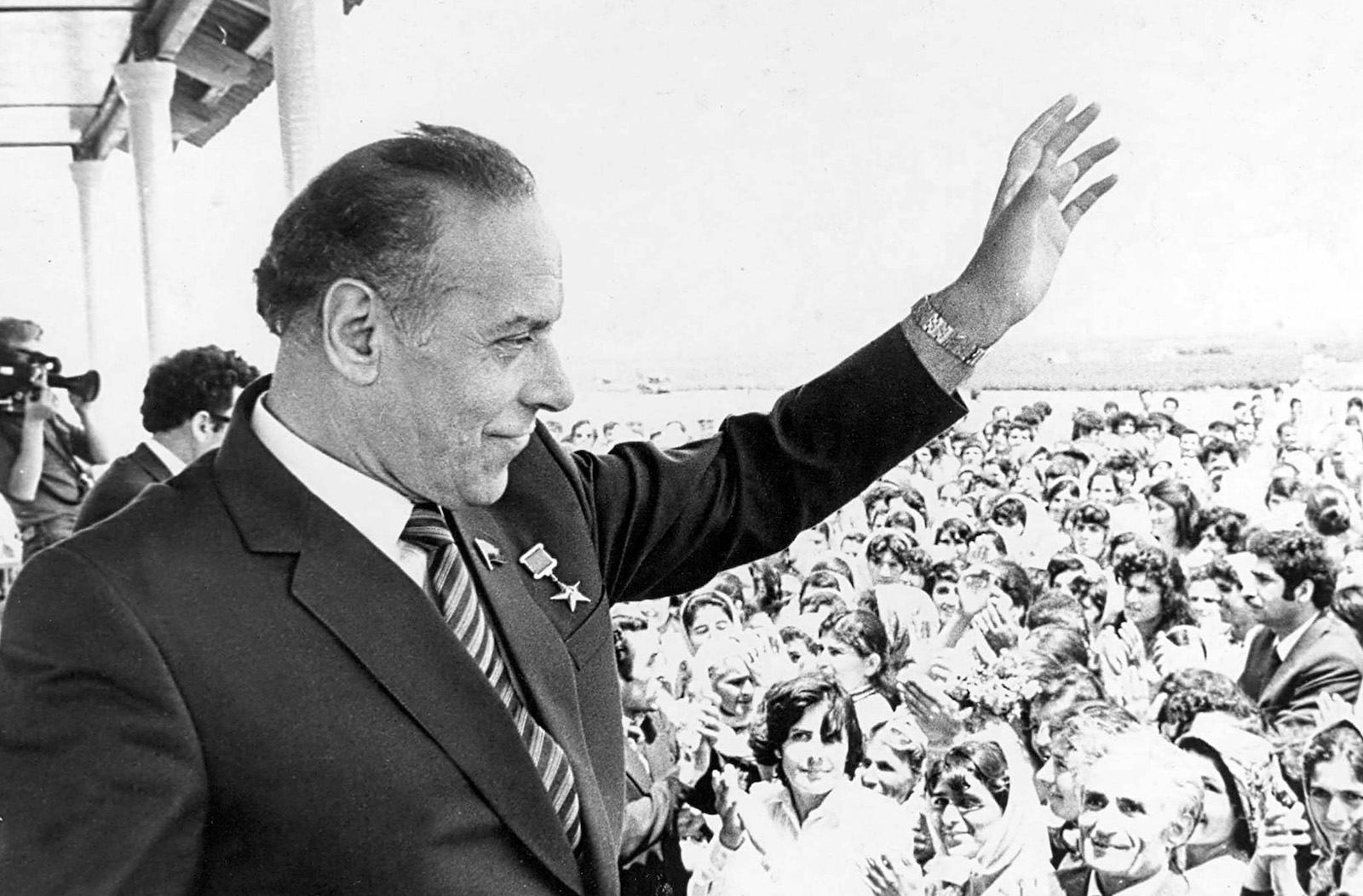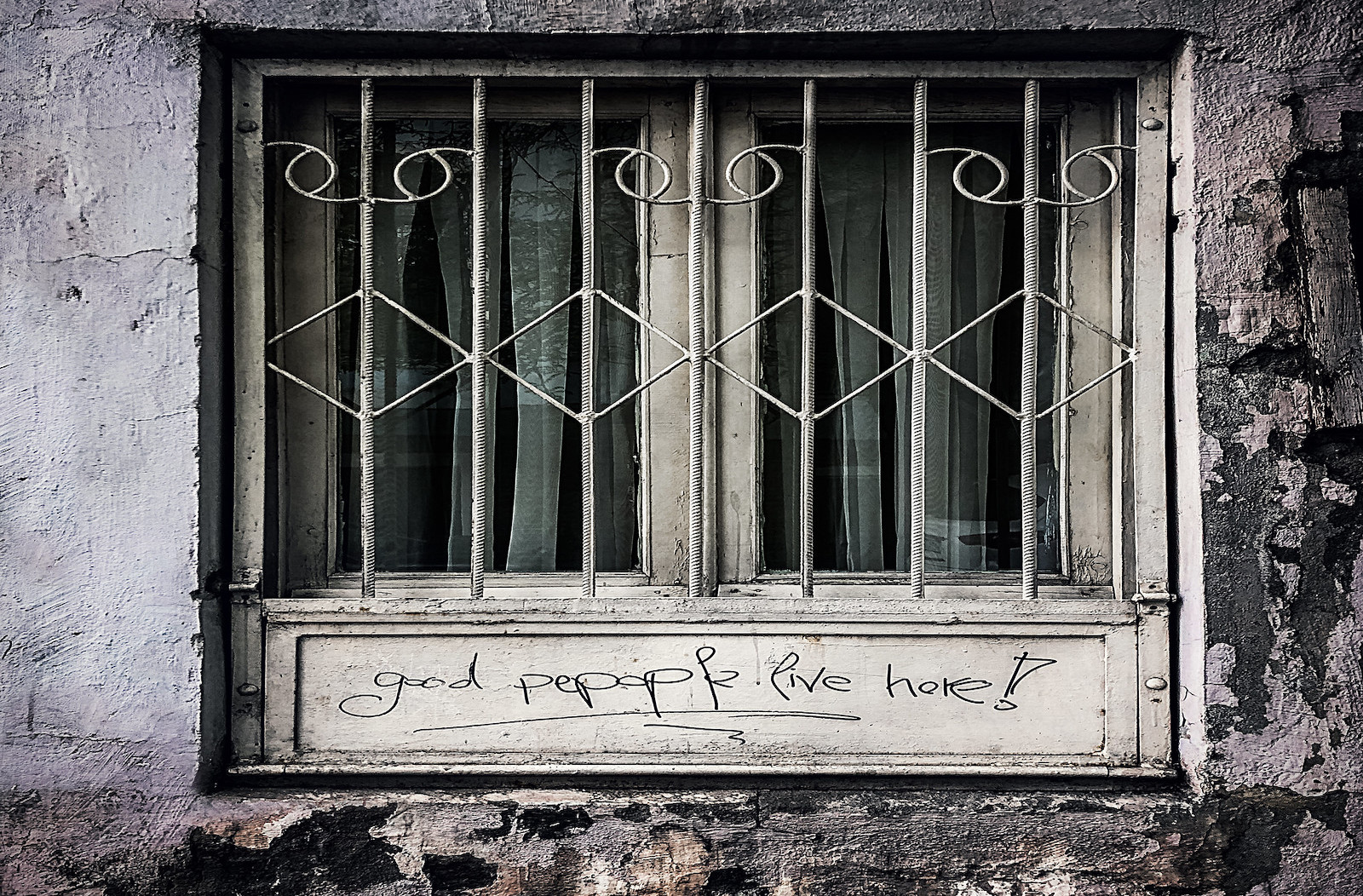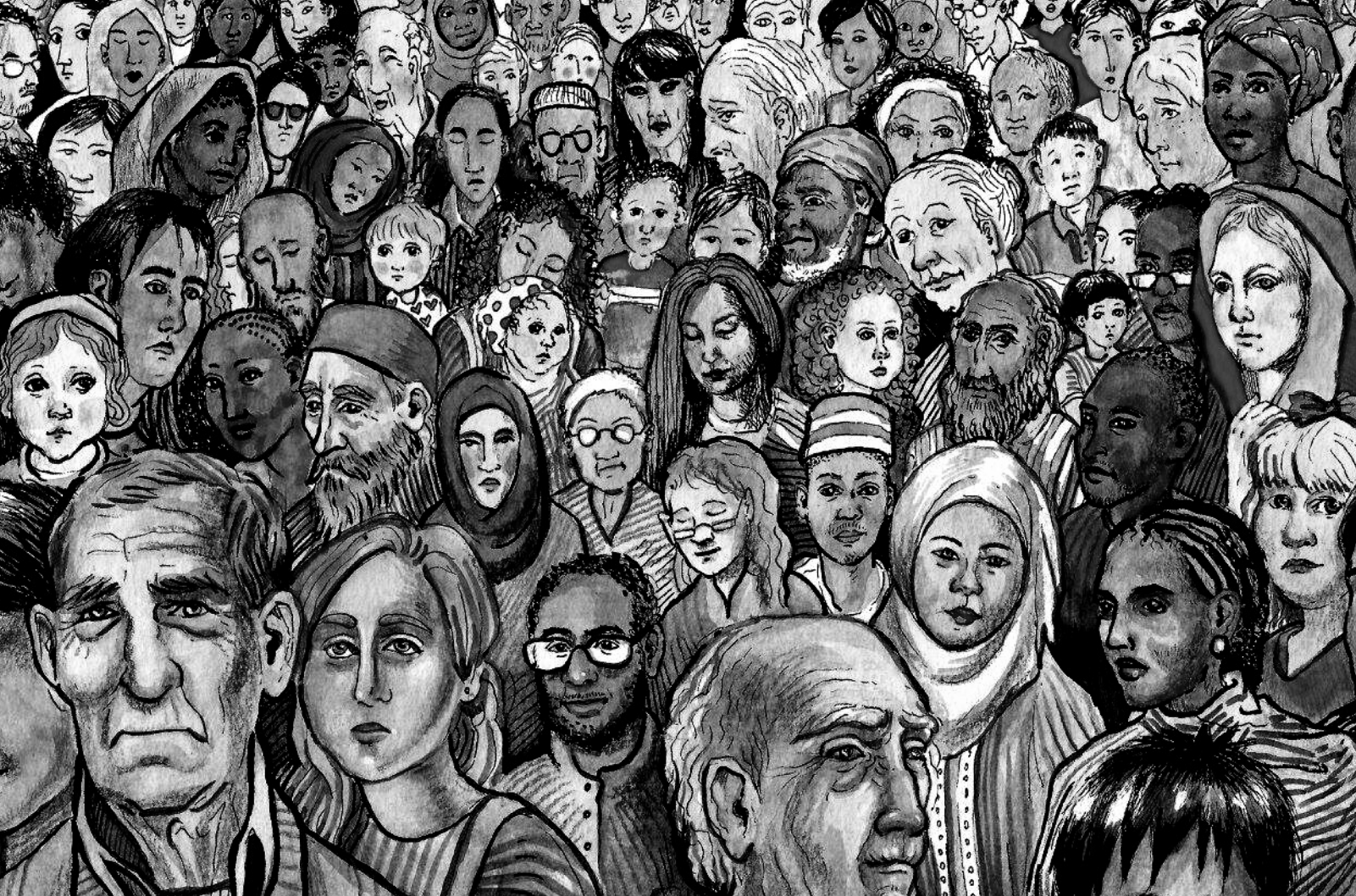
Oil Builds Statues – Effigies of Greed
Once upon a time, there was a man,
Who had tons and tons of oil wells.
He drilled and killed as much as he willed,
Forging, gilding all his deeds.
Futile were his hordes of sins,
Veiling all of pogrom yields.
With stygian gold he used to preach,
And got himself some statues built.
(Building his effigies of greed)
At the center of our multicultural city stands an effigy of greed, shamelessly disgracing all of the city’s denizens, while also disrespecting a huge ethnic group inside the country, as well as outside of it. But before we get to that ethical dilemma, let’s talk about the statue itself for a little.
The statue I’m talking about has the face of Heydar Aliyev. Built in 2007, the statue stands smugly in the park named after the same person. And just in case you simply can’t get enough of gazing at this man’s face, you will find information on the statue about how far away (in km) his statues in Baku and Ankara are. But don’t you worry! We won’t have to go that far because we have a few more of those here in Georgia, too.
The construction of this piece of art was financed by Sokar, one of the largest oil & natural gas companies in Georgia. No surprises here – an oil company building a statue of the former president of the oil country with oil money.
As if one statue wasn’t enough for our country, the second city in Georgia, Rustavi, decided to erect another one together with a park. It would obviously bring shame to their city if they hadn’t done so. The opening ceremony was attended by Azeri and Georgian officials who jointly adorned the magnificent sculpture with flowers.
After this phenomenal opening, yet another city, Marneuli, decided that they were missing out on something big and immediately conjured another bust of Heydar. It’s no wonder that now we have more sculptures devoted to this man than to Queen Tamar.
You might not know that a huge part of the Mtkvari embankment is also named after our dear Heydar. Let’s recap: throughout the country, we have at least three sculptures, three parks, four streets, one embankment, and a theatre devoted to Heydar Aliev. Now, please tell me how many parks, streets, and sculptures we have of – let’s say, George V the Brilliant? Exactly, but this is not the point I’m making here, it’s just funny.
If you don’t know anything about this man, you might not really care whether we have a sculpture or two devoted to him or not. However, we are going to fix that now and tell you why it’s a disgrace for Georgians to honor a man like Heydar Aliyev.
Sins of Heydar Aliyev – Massacres, Corruption, and Autocracy
Now, there has been exactly one prominent Heydar Aliyev in Azerbaijan’s recent history. A KGB chief turned Stalinoid Communist satrap-cum-mafia kingpin of the Soviet autonomous region, who found it necessary to bribe Leonid Brezhnev in order to remain in power, and later the first president of post-Soviet Azerbaijan from 1993. Before he died and his presidency ended in 2003, Aliyev managed to own banks and create one of the world’s most corrupt countries. But these are not the sins we’re after. His most bloody sins can be found in the Nagorno-Karabakh conflict.
Shortly before the Ottoman Empire’s capitulation in the war, the Russian Empire collapsed and fell into the control of the Bolsheviks in November 1917. The three nations of the Caucasus, (Armenia, Azerbaijan, and Georgia) were previously under the rule of the Russians and declared independence. Fighting soon broke out between the Democratic Republic of Armenia and the Democratic Republic of Azerbaijan in three specific regions: Nakhichevan, Zangezur (today the Armenian province of Syunik), and Karabakh itself.
About eleven months later, the Red Army invaded all three countries in the Caucasus, and within just three years, they were incorporated into the Soviet monstrosity. The conflict between Armenia and Azerbaijan was resolved by Stalin when he presumably forced the communist party’s Caucasian bureau to transfer the Nagorno-Karabakh region to Soviet Azerbaijani control, trying to placate Turkey to join Russia against the Entente.
In 1987, the conflict between the Armenians in the oblast and the government of the Azerbaijan SSR broke out. This is where Heydar Aliyev comes into play since he had been the leader of Soviet Azerbaijan, as well as the head of the KGB of the Azerbaijan SSR since 1969. As if this military conflict wasn’t enough, ethnic infighting soon broke out between Armenians and Azerbaijanis living in Karabakh.
The first violent riot, or pogrom, aimed at massacring ethnic Armenians, took place in Sumgait by the end of 1987, leaving dozens of Armenians injured or dead. The manner in which many Armenians were killed reverberated amongst Armenians who felt the pogrom was backed by government officials to intimidate those involved in the Karabakh movement. It is not far-fetched to speculate that the pogroms against Armenians in Azerbaijan were instigated by the notorious local mafia, which was controlled by KGB official Heydar Aliyev, in order to create a situation in which Gorbachev would lose, no matter what he did. He could not side with the Armenians because by doing so he would alienate the Muslims, but by taking a neutral position, he drove the Armenians, who would have otherwise been his natural supporters, into active opposition.
Following the event, most of the Armenians who lived in the region began to evacuate, but before it could be put into action in 1988, another similar disaster occurred in Kirovabad. One can now see the organization with which the perpetrators were acting out. The conflict resulted in over two hundred wounded Armenians and more than a hundred and fifty dead.
The culmination of pogroms took place in Baku at the beginning of 1990. The person who played a major role in the Armenian pogroms in Baku was Heydar Aliyev, who had yet to become president of Azerbaijan, but said that there was no need to be afraid of bloodshed and the more the better. The pogrom led to the murders of nearly a hundred people and the expulsion of more than 200,000.
An Azerbaijani historian and human rights advocate, Arif Yunusof, who emigrated to the Netherlands to escape persecution in his country, wrote this about the Baku pogroms:
“The Communist Party of Azerbaijan was to convene a plenary session of its Central Committee in late January to dismiss Heydar Aliyev and his entire [political] team from the party and to later oust them all from the political arena. Aliyev was certainly aware of the fact, so he initiated counteractions through his allies across the republic. A central figure in the Azerbaijani National Front was Neymat Panahov, whom Aliyev had told at one of the meetings that they needed ‘a lot of blood’. So on December 31, 1989, Panahov organized the border transgression plot in Nakicevan even though Moscow had already signed the agreement to allow the opening of the border. They promised there would be no fire attacks by border guards of the National Security Committee. So Panahov himself was the perpetrator of the Armenian pogroms in January 1990, as a day of a heroic struggle for the state’s independence and part of their national liberation movement.”
Prior to that, in Baku, the Azerbaijani government preferred to largely remain silent about the Sumgait pogroms, following the saying “let sleeping dogs lie”. At the same time, they knew very well what happened in Sumgait and Kirovabad.
There were about half a million refugees and hundreds of casualties, including the elderly, women, and children, as a result of the pogroms in Baku, Sumgait, and Kirovabad.
Reciprocal atrocities coinciding with the collapse of the Soviet Union caused the outbreak of all-out war in the early 1990s. The Khojaly Massacre on February 26, 1992, brought another great loss of life in the conflict, which continues to this day under a shaky ceasefire agreed in 1994. In the early morning hours, advancing Armenian fighters opened fire on a stream of mostly civilian Azeris fleeing the town of Khojaly in the Nagorno-Karabakh region. The massacre resulted in the deaths of around a hundred and fifty ethnic Azerbaijanis, including the elderly, women, and children.
As an answer to this Armenian village, Maraga was attacked by the Azerbaijani forces. By that time, according to the data from Human Rights Watch, the village had 500 residents. As a result of the attack, most of the village was burnt and destroyed – around seventy residents of the village were killed, and forty-five civilians were taken as hostages.
In a grim escalation of the information war between the two sides, the leaders of Armenia and Azerbaijan have each repeatedly discredited conspiracy theories regarding the massacres. Azeris say that Sumgait, Baku, and other events were carried out by Armenians themselves for the sake of PR, and Armenians say that the Khojaly massacre is “a blatant lie”. This is denialism of known and proven historical facts in full force.
And now before some pseudo-intellectual prick starts screaming that we are biased against Azeri and are backing the Armenians, I will say this: The article IS about “why Heydar Aliev’s statue is a disgrace to our city” and NOT about “picking favorites between warring sides. After all, you don’t see a statue of Serzh Sargsyan, Robert Kocharyan or Levon Ter-Petrosyan (former presidents of Armenia, the latter either ordered or took part in the 1992 Khojaly massacre, which resulted in the deaths of hundreds of Azeri people) being paraded throughout the country, but we continue to lick the oily dead ass of Heydar Aliyev (who designed the pogroms of Sumgait, Kirovabad, and Baku, killing hundreds of Armenians). This doesn’t quite sound right to me.
Heydar Aliyev’s Statues, Parks, and Streets are a Disgrace
First of all, it’s extremely disrespectful to all those hundreds of thousands of ethnic Armenians living in Georgia for centuries. Now, don’t give me some shit about how Armenians should not be living here and that they are somehow intruding on us and all that bullshit. They are the citizens of this country as much as we are, having equal civil rights and liberties. The fact that we are not on so very good terms with the Armenian government isn’t relevant here.
Would you like to live and raise your kids in a country where streets and statues and busts, and parks are devoted to Stalin? Or if you are an oh so bright-minded Stalin-denialist, then to Murvan Qru (Marwan the Deaf)?
But even if you couldn’t care less about hurting Armenians’ feelings, still, it isstill not okay to honor a bloody dictator. If your argument is that Aliyev did nothing bad to us and therefore it doesn’t matter if we devote stuff to him, then let me remind you that so did Mao Zedong, Idi Amin, and Augusto Pinochet. They didn’t harm us in any tiny bit of a way, while hundreds of thousands of people were killed under their regimes. So, is it okay to build their statues too?
No, we wouldn’t build their statues, because they don’t have oil flowing out of their body orifices. But Aliyevs do, so we build them statues. It’s amazing what oil money is capable of doing.


